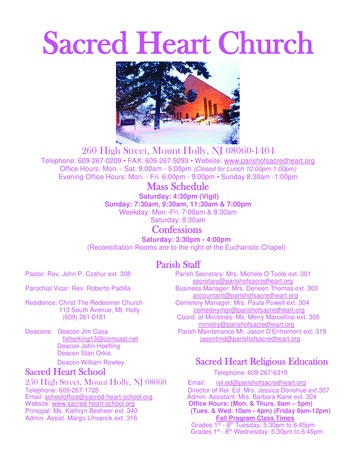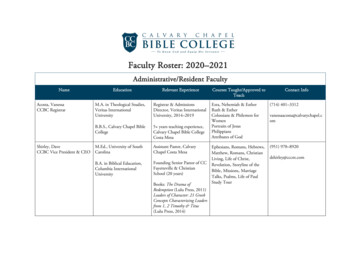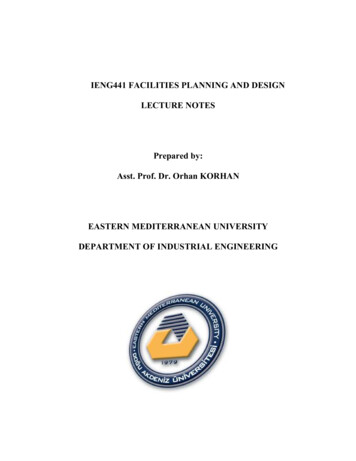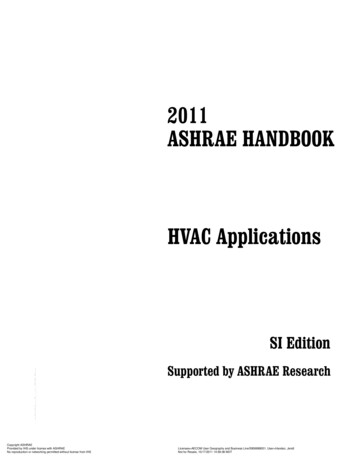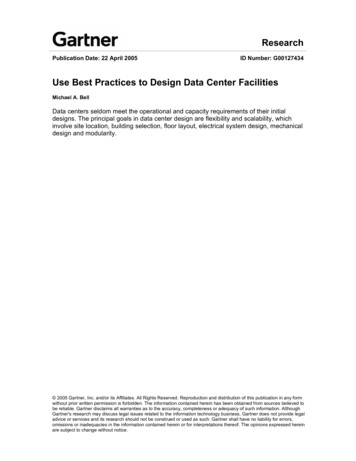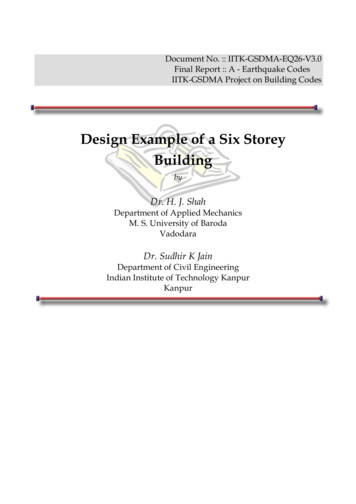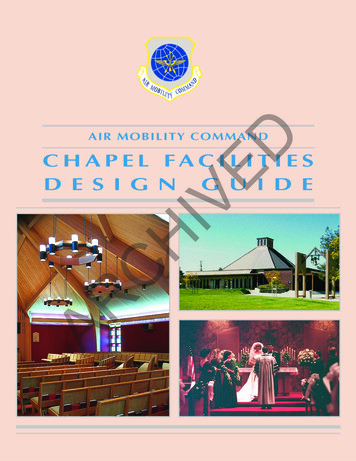
Transcription
DAIR MOBILITY COMMANDARCHIVEC H A P E L FA C I L I T I E SD E S I G N G U I D E
DIVEHChapel facilities symbolize people’s pursuit of the highest and bestin life’s experience. This means AMC’s chapel facilities, its“sacred spaces,” must be functional and spiritually uplifting.ARCAir Mobility Command is strongly committed to upgradingchapels, where worship, counseling, religious education, socialgatherings, weddings, baptisms, and many other significantexperiences take place. The goal is bold: to enter the nextcentury with the best chapel facilities in the Air Force.Wing commanders should make chapel facilities improvementsa high priority. AMC has have developed this guide as a blueprint for excellence – it is invaluable when planning projects tobring chapel facilities up to these new standards.“The Air Mobility Team.Responsive Global Reach for America.Every Day!”i
Table of ContentsChapter 1Introduction1DA. PurposeB. Project Development1. Planning2. Programming3. Design4. ConstructionIVEChapter 2Exterior ElementsGeneralSignsLandscapingParking AreasEntries and Entry PathsChapter 3Functional AreasHA.B.C.D.E.ARCA. Worship Areas1. General2. Sanctuary3. Narthex4. Sacristy5. Baptistry6. Blessed Sacrament and Reconciliation Room7. Choir Room8. Cry Room9. Bride’s Room10. All Faiths RoomB. Counseling Areas1. General2. Waiting Area3. Senior Chaplain’s Office4. Chaplains’ OfficesC. Staff Support Areas1. General2. NCOIC’s Office3. Secretary’s Office4. Chaplain Service Support Personnel Workspaces5. Staff Support and Mobility Supplies Storage Roomii35
TABLE OF CONTENTSChapter 3Chapter 4CHIVED. Activities Areas1. General2. Multi-Purpose Room3. Kitchen4. Conference AreaE. Religious Education Areas1. General2. Classrooms3. Religious Education Coordinators’ Workspaces4. Resource Center and LibraryF. Support Areas1. Mechanical Room2. Janitor’s Room3. Electrical/Communications Room4. Rest Rooms5. StorageG. Other Chapels/Offices1. General2. Flightline Chaplain’s Office3. Hospital Chapel/Meditation RoomDFunctional Areas (Cont’d)Interior StandardsGeneralColor ConceptsFloor CoveringsWallcoveringsWindow CoveringsStained Glass WindowsCeilingsAccessoriesSignsSystems .J.K.L.17References24iii
TABLE OF CONTENTSList of FiguresDescriptionFunctional Area RelationshipsConcept Site PlanConcept Floor PlanDescriptionChapel Functional Space RequirementsOther Chapels/Offices Functional Space RequirementsFinish ScheduleEquipment ScheduleFurnishings ScheduleOF THETAIENRCED E PA RFOARRTMCHNumberTable 3-ATable 3-BTable 4-ATable 4-BTable 4-CIVEList of TablesPage1316DNumberFigure 1-AFigure 2-AFigure 3-ACHivAPMCMXLIXL A I N S E RV ICEPage1516202122-23
Chapter 1IntroductionIVEThis guide provides the basic criteria to organize, evaluate,plan, program, and design Air Mobility Command (AMC)chapel facilities. The information presented is intended tomake commanders and their staffs aware of importantdesign considerations and to aid them in project development. Chapel facilities should present a quality environment for religious, social, and humanitarian services to thepeople of AMC. These facilities should project an atmosphere of dignity, warmth, and professionalism. This guideis for use by commanders, base civil engineers, chaplains,Headquarters AMC staff, design architects and engineers,and others involved in chapel facilities renovation andconstruction projects. It is intended to help all participants better understand AMC chapel facilities designstandards for effective participation in the project development process. Use this guide to supplement other AirForce and Department of Defense policies and instructions.DA. PurposeHThe eight functional areas which make up chapel facilitiesinclude the exterior elements, worship areas, counselingareas, staff support areas, activities areas, religious education areas, support areas, and other CESCSERVICE KINGRELIGIOUSEDUCATIONAREASOUTDOORPATIOSTAFF SUPPORTAREASMAIN ENTRANCEEXTERIOR ELEMENTSFigure 1-A: Functional Area Relationships.1
INTRODUCTIONThe key elements to successful facility delivery are planning, programming, design, and construction.1. PlanningGood planning establishes the objectives for an effectiveprogram and provides the facilities necessary to meet theobjectives of the chaplain service. It should also lead toa timetable for project completion. Planning must belong-term.3. DesignDesign includes concept development, design reviews, andconstruction documents. It is important for civil engineering and the user to actively communicate throughout thedesign process to bring about a successful project.IVEWhen planning a new facility, complete the site selectionprior to preparing a DD Form 1391, Military ConstructionProject Data, for an individual project.Chapel facilities listed or eligible for listing on theNational Registry of Historic Buildings require specialconsiderations. Before initiating repairs and/or upgradeprojects, consult with the State Historic PreservationOffice and the Advisory Council on Historic Preservation.The Legacy Resource Management Program is a possiblesource of funding for work on historic properties. ConsultAir Force Instruction (AFI) 32-7065, Cultural ResourcesManagement.DB. Project Development2. ProgrammingLife safety code requirements take precedence over otherfacility improvement requirements. All areas should bebarrier free and accessible to the disabled in accordancewith the Americans with Disabilities Act (ADA) andUniform Federal Accessibility Standards.HProgramming includes determining user requirements,developing solutions, identifying funding sources, andforwarding programming documents to the appropriatereview and approval authorities. Each programmed projectshould be consistent with the base comprehensive plan fornew and existing facilities. Work is classified as maintenance, repair, or minor construction.ARCInformation required during preparation of theDD Form 1391, which initiates project development, isfound throughout this guide. Included are considerationsof space criteria, overall facility size, and special factors foruse in estimating costs.The designer should complete an overall comprehensiveinterior design (CID) standard for the facility beforebeginning any major design project. The CID standardaddresses interior finishes, artwork, signs, equipment, andfurnishings. It ensures even small upgrade projects support the design objectives for the entire facility. Refer tothe AMC Interior Design Guide for an expanded discussion of interior design. Integration of engineering,architectural, and interior design considerations duringproject development creates a well-coordinated interiordesign. Analyze an existing facility’s structural, electrical, communications, and mechanical systems beforeplanning interior design upgrades. The designer shouldinclude infrastructure improvements concurrently withinterior finish work when appropriate.4. ConstructionRenovation projects for historic facilities require consultation withthe State Historic Preservation Office and Advisory Council onHistoric Preservation.2Quality reviews of the contractors’ submittals by projectengineers and frequent on-site inspections by civil engineering construction management personnel and the user will help ensure design goals are met.
Chapter 2Exterior ElementsA. GeneralIVEExterior elements contribute to the first impression visitorshave of the chapel and the quality of services providedthere. This chapter addresses the concept site plan, signs,landscaping, parking areas, and entries and entry paths.The architectural compatibility guide for each base willhelp in the design of these elements. Avoid using materials that create an industrial, commercial, or institutionalappearance.Locate new facilities near the family support center,youth center, and gymnasium for shared parking.This is also necessary because the chapel sponsorseducational and recreation programs in these facilities. The chapel should also be near dormitories,temporary living facilities, and visiting officer quarters because these chapel users will typically walk tochapel services.Do not use religious symbols.D H ARKINGOUTDOORPATIOMAINENTRANCEVISITOR DROP-OFF AREABUILDINGENTRYSIGNOUTSIDESCHEDULEBOARDMAIN ROADFigure 2-A: Concept Site Plan.3
EXTERIOR ELEMENTSB. SignsInclude facility, directional, and parking signs that meetAMC sign standards. Provide a building entry sign onthe site to clearly direct visitors to the main entrance.Chapels also require an outside schedule board thatcomplements the design of the building.IVELandscaping elements help create natural beauty forvisitors entering the chapel facilities. These elementsinclude water features, earth berms, shrubs, trees, andflowers. Landscaping helps screen parking areas anddefine building entries. Terraces and patios that serveas informal gathering places or settings for outdoorwedding ceremonies should include features such astree-lined pathways, garden fountains, or ornamentalponds. Refer to the AMC Landscape Design Guidefor specific information.DC. LandscapingHUse outside schedule boards that complement the facility’s design andmaterials.D. Parking AreasProvide outdoor patios or terraces with seating for group gatherings.ARCParking areas should be adjacent to chapel facilities,but not in front of the buildings. Provide well-lightedparking areas with adequate spaces for peak attendanceevents. Locate handicap parking spaces near buildingentrances. Include designated spaces for employeesand distinguished visitors.E. Entries and Entry PathsThe facility entries and entry paths should be easilyidentifiable to first-time visitors. Include several entryways with multiple doors to accommodate the arrival anddeparture of people at large gatherings. Provide a vehicular driveway at the main entrance with a visitor drop-offarea. Include a secondary entrance to the religious education and activities areas for public use. Provide aseparate entrance to the counseling areas for staff use. Locate a service entrance near the mechanical room.Special features should be architecturally compatible with the chapeldesign.4
Chapter 3A. Worship Areas1. GeneralThe chapel should be easily identifiable with a high,steeply pitched roof over the primary worship space. Theuse of stained glass sets chapel facilities apart as places ofbeauty and spiritual inspiration.ARCHIVEThrough the chaplain service, the commander isresponsible for the religious support of base personnel.This support includes community worship, individualmeditation, pastoral counseling, and religious education.Chapel facilities provide the sacred spaces in which theseactivities are conducted.DFunctional AreasHigh ceilings in the sanctuary help create a visually and spiritually uplifting space.5
FUNCTIONAL AREAS2. Sanctuary The narthex is at the main entrance to the facilityand serves as the entryway to the sanctuary. If possible,provide windows between the narthex and sanctuary sothat services can be viewed from the narthex area. Thecolor scheme, appointments, and character should matchthose of the sanctuary. Storage for coats, hats, and umbrellas should be near this area.Public address systems should provide quality soundreproduction.Sanctuary lighting should provide bright, even illumination, even at night, so worshipers can read fromliterature and hymnals. Provide separate switches, withrheostat controls for the chancel, choir area, nave, andnarthex (entryway to the sanctuary). Spotlights shouldfocus on the altar, lectern, and pulpit.Upholstered worship chairs allow a variety of seatingarrangements and are an acceptable alternative tostationary pews.4. SacristyActivities in this room include preparation of communionand vestment changing for the clergy. The sacristy shouldbe adjacent to the chancel at the front of the sanctuary.Provide storage cabinets for altar appointments, communion supplies, and clerical robes. Include a full-lengthmirror near the robe cabinet. Costly altar appointmentsand sound system equipment should be in securable cabinets. Cabinet and drawer signs should be uniform andclearly descriptive of contents.AR CH 3. NarthexIVEConsider using wood finishes on walls, ceilings, and furnishings to convey warmth and beauty, and to help thespace be visually inspiring. Investigate acoustic requirements for this space prior to selecting interior finishes. DThe sanctuary is the congregation’s gathering place forworship. This space includes the chancel (altar area),nave (pew seating area), and choir areas. All seatingin the nave should provide an unobstructed view of thechancel. Consider elevating the chancel floor from thenave floor level to help worshipers see the services atthe chancel. Seating, choir, and chancel areas can varyin design to accommodate chapel seating requirements.See Figure 3-A, Concept Floor Plan, for an example of asanctuary design.Incorporate stained glass windows along exterior walls,if not already present. Windows should not containreligious symbols. Ensure stained glass colors harmonize with the sanctuary interior color scheme.Coordinate the upholstery on pews and kneelers withthe sanctuary color scheme.Provide seating in the narthex to accommodate visitors awaiting aproper time to enter the sanctuary.6The sacristy requires storage cabinets for supplies and a work counterfor the preparation of communion.
FUNCTIONAL AREASBaptisms are performed in the baptistry. This space istypically part of the chancel. Baptism may involve theapplication of water from a baptismal font or immersion ina baptismal pool. The design of the pool and font should complementthe chancel design scheme.Provide changing rooms (men’s and women’s) withnon-skid flooring, sinks, and mirrors.Use ceramic, brick, or stone finishes for those parts ofthe baptistry that are visible from the sanctuary andchancel. Prefabricated baptismal pool assemblies maysimplify construction and installation.8. Cry RoomA cry room permits parents with infants and toddlers toobserve worship services without disturbing the congregation. The room should be adjacent to the sanctuary andhave a sound-proof wall with windows. Provide publicaddress system speakers so the service can be heard inthis room. Use other space in the building for a childcare or junior church area.IVE cabinet for choir members’ valuables, choir robe storagecabinets, a full-length mirror, and storage for sheet musicand music stands.D5. Baptistry6. Blessed Sacrament and Reconciliation Room Consider including a sink with hot/cold water, andspace for a playpen, rocking chair, and a diaperchanging station.Include this room for the Roman Catholic clergy’s storageof blessed elements of the sacrament, for the hosting of theSacrament of Reconciliation (Confession), and for prayerand meditation.AR7. Choir RoomH Provide stained glass window features. Consider rearilluminated stained glass where there are no exteriorwalls.Select portable confessional screens and portable chairswith kneelers. Coordinate the style and color schemesof these furnishings.C The choir room provides a space for choir members torehearse, robe, and store choir supplies. Include a lockableThe design of the baptismal pool and font should complement thechancel design scheme.A stained glass window in the Blessed Sacrament and ReconciliationRoom creates an atmosphere for meditation and prayer.Cry room windows allow parents with infants to view chapel services.7
FUNCTIONAL AREASB. Counseling AreasWeddings are frequent ceremonies held at the chapel. Thebride’s room provides a space for the bride and her attendants to dress and prepare. The room should be adjacentto the sanctuary and women’s rest room. This room alsofunctions as a women’s lounge. Provide a dressing table with mirror and make-up lights,a full-length mirror, seating, and hanging space for fulllength clothes.10. All Faiths Room Offices should accommodate a desk, filing cabinet,computer work station, and a counseling area withchairs.Select fabric wallcoverings that will provide soundabsorbing capability.Provide finishes and window treatments comparable toother worship spaces.Place a quality, lockable cabinet in this room for safekeeping of sacred items. ARCH Chaplains serve as counselors for the base community. Thecounseling areas should be in a private part of the chapelfacility. AFIs and the Uniform Code of Military Justice(UCMJ) affirm the right of confidentiality for a counselee’sconversation with a chaplain. Therefore sound-proof thechaplains’ offices so conversation cannot be heard outsideof their offices. The counseling offices in these areas shouldcreate a residential, warm, and private feeling.IVEConsider Buddhists, Muslims, and other faiths when planning chapel renovations. Members will require a space forprayer, meditation, and rites.1. GeneralD9. Bride’s RoomUse full-length mirrors in the bride’s room so the bride and attendants can prepare for wedding ceremonies.8
FUNCTIONAL AREAS2. Waiting Area3. Senior Chaplain’s OfficeTimes of crisis often bring people to their clergy for solaceand guidance. Therefore, waiting areas should provide anenvironment of comfort and privacy. The waiting areashould not be in a public corridor.The senior chaplain hosts commanders and distinguishedvisitors in this office. Design this room to accommodatethese meetings and for consultations with staff chaplains. Locate the waiting area near the reception windowso the visitors can be directed to the appropriatechaplain’s office.Include reading material display racks, comfortableseating, plants, and artwork. Furnish the office with executive-quality wood furniture and coordinated, upholstered chairs and sofa.Provide multiple seating for consultation meetings.Use a chair rail for wall protection from furniture.Consider a coordinated wainscot material.D 4. Chaplains’ OfficesIVEProvide wood desk furniture and coordinated upholsteredchairs in these offices. H Allow sufficient space to arrange chairs for counselingand informal conversation.Provide book cases to accommodate chaplains’ theological and ecclesiastical reference libraries.Include a closet for storage of clerical robes and religious education resource items.Select live plants or professional quality silk plants.C ARThe waiting area should be in a private space because visitors frequently see the chaplain in times of crisis.C. Staff Support Areas1. GeneralChapel staff support includes record keeping, correspondence, preparation of worship bulletins, public relationswork, funds accounting, facilities scheduling, and a widevariety of customer support tasks. The chapel staff workarea may be an open office environment using systemsfurniture. This area should have easy traffic flow andinclude a convenient customer service counter at thereception area.2. NCOIC’s OfficeThe NCOIC needs private office space to accomplishsupervisory counseling with junior staff members. Locatethis office adjacent to the chaplain service support personnel work spaces and near the senior chaplain’s andsecretary’s offices.The senior chaplain’s office should have executive quality woodfurnishings and space for consultation meetings.9
FUNCTIONAL AREAS The secretary prepares executive correspondence andmonitors the senior chaplain’s meeting schedule andappointments. Locate this office near the senior chaplain’s office and waiting area. Equip this office with atelephone and a computer with Local Area Network(LAN) connectivity for staff support.4. Chaplain Service Support Personnel Workspaces5. Staff Support and Mobility Supplies Storage RoomThe chaplains and support personnel require a separateroom for storing supplies and using the bulletin foldingmachine. Provide shelves, cabinets, and floor space fora variety of items. Mobility bags, chemical warfare gear, as well asProtestant and Catholic field kits with supplementalmobility boxes (containing literature, worship supplies,etc.) will need floor space or deep shelving.Paper, desk items, and computer supplies should bein a cabinet.IVEChaplain service support personnel accomplish alllogistical, financial, and ancillary tasks in support ofthe chaplains’ services. Equip each of their workspaceswith electrical power and telephone outlets. Providefile and storage cabinets for facility records. Selectceiling tile, carpeting, and sound absorbent partitionsto minimize noise. Include space for a joint use photocopier, common useLAN laser printer, and facsimile (FAX) machine.Provide matching professional, wall-mounted bulletin,staff sign-out, and facility scheduling boards.D3. Secretary’s OfficeARCH Use systems furniture that integrates storage cabinets, electrical power, and telephone outlets.10
FUNCTIONAL AREAS 1. GeneralThese areas include large group meeting rooms, entertainment space, and overflow seating space for worship.Locate these areas near the sanctuary and main entranceto the facility.2. Multi-Purpose Room Select furnishings (folding tables and chairs) for themulti-purpose room on the basis of maintainability,durability, uniformity, and appearance.Provide public address speakers in this room for theoverflow congregation.If there are no windows to the sanctuary, provide aclosed circuit television so the overflow congregationcan observe worship services.ARCHIVEThis room serves as a fellowship area for coffee hoursbefore and after worship, as a dining area for meal-centeredevents, as a reception area, and as a worship overflow seating area. Install sound absorbent, movable walls to allowfor separate, simultaneous functions.DD. Activities AreasMovable walls allow the multi-purpose room to accommodate private, multiple activities.11
FUNCTIONAL AREAS The kitchen should be capable of supporting catered mealsfor gatherings of up to several hundred people. Locate thisroom adjacent to the multi-purpose room and include aclosable serving window between the rooms. E. Religious EducationAreas1. GeneralReligious instructors teach courses and conduct administration work in these areas. Collocate these areas with theactivities areas, which may serve as additional classroomspace.IVE Provide storage for cooking utensils and nonperishable foods as well as a lockable cabinet forcleaning supplies.Floors, walls, and ceiling materials should be durableand easy to clean.Select industrial-quality appliances, including garbagedisposal, dishwasher, range with oven, microwave, andrefrigerator with ice maker.The number of power outlets should be sufficient toaccommodate portable appliances brought in for largefunctions.Provide a double bowl stainless steel sink withhose rinser.Include a wall-mounted telephone in this room.4. Conference Area2. ClassroomsReligious education classrooms should accommodate up to30 people. Provide tables that adjust in height and chairsof different sizes for different age groups.H Provide a ceiling-mounted projection screen and wallmounted conference whiteboard for audio-visualpresentations.Include space for a conference table and chairs, additional seating along the outer walls, an audio-visualcart, and freestanding instructional aids.D3. Kitchen Install safety electrical outlets in rooms used by smallchildren.Include lighting with dimmers so participants can viewfilms and take notes.Use movable walls between classrooms so they can becombined to accommodate larger groups. Provide countertops and electrical outlets in the kitchen to supportportable appliances brought in for large functions.Equip classrooms with erasable whiteboards and teaching materialsstorage cabinets. ARCThis space is for council and committee meetings, religiouseducation classes, and chapel staff meetings. Other baseorganizations will also use this room. This space can bepart of the multi-purpose room or a separate room. Ineither instance, the space should have walls that inhibitnoises from outside the room.12
FUNCTIONAL AREAS3. Religious Education Coordinators’ Workspaces4. Rest RoomsReligious education coordinators maintain the programsand instructor schedules. They need office space for thisadministrative work. Locate their workspaces adjacent tothe classrooms. Typically, there will be one Protestant andone Catholic coordinator.Provide two sets of rest room facilities. Locate a smaller setadjacent to the counseling area and a larger set near theworship, activities, and religious education areas.4. Resource Center and Library Provide book cases of professional quality andappearance.F. Support Areas1. Mechanical Room IVEThe resource center and library contains accountable professional books and other resources provided by the USAFChaplains’ Resource Division for the chaplains’ use. Thelibrary, similarly, serves as a repository of religious books.Collocate the resource center and library in a room thatmay also serve as a classroom or conference room.Men’s rest rooms should include toilets, urinals,sinks, partitions, mirrors, soap dispensers, toilet paperdispensers, a diaper changing station, a shelf for capsand small items, and waste receptacles.Women’s rest rooms should include the same accessories as the men’s, excluding urinals, but includingsanitary napkin dispensers and disposal.D Provide a lockable storage room near the classrooms foreducational materials and teaching aids (books, papers,films, videos, VCR cart, tapes, tape player, arts and craftsmaterials, seasonal materials, etc). Include shelving andcabinets for their storage. Direct access to this room fromthe exterior allows convenient delivery of bulk, annualsupplies. Large quantities of tables, chairs, bulk papersupplies, seasonal decorations, and other items requirestorage adjacent to the multi-purpose room. Use freestanding cabinets and wall-mounted shelving to improvestorage capacity. Provide double door access to the storage area from the multi-purpose room.ARCHChapels contain many areas that require a quiet, meditative environment. Provide sound insulation in this roomto prevent noise from disrupting worship, counseling, staffsupport, and religious education areas. Include a doubleservice door to the exterior and a concrete ramp for theconvenient moving of large equipment and parts in andout of the room. Consider an outdoor mechanical areathat screens large equipment supporting the facility.5. Storage2. Janitor’s RoomProvide a deep sink and storage space for cleaning suppliesand equipment. Include ventilation for drying of wetcleaning equipment.3. Electrical/Communications RoomWall-mount the power and telephone distribution equipment, and floor-mount the LAN computer file server inthis room. Install a system of conduits (or raceways) fortelephone and computer wiring with a central feed to thisroom. Conduits/raceways should have nylon pulling lineand be easily accessible.Locate a table with chairs in the resource center and library.13
FUNCTIONAL AREAS 1. GeneralChaplains’ duties also include counseling personnelworking in the operations and maintenance facilities ofthe base. They require an office and a meeting room atthese facilities to provide this service. 2. Flightline Chaplain’s Office A small lockable office should adjoin a meeting room.The chaplain will use this office for private consultations as well as administration responsibilities. Equipthe telephone with an answering machine becausethere is no secretary to answer calls when the chaplainis away from the office.3. Hospital Chapel/Meditation RoomHospital chapels and meditation rooms should receive thesame design consideration as the chapel facilities in thisdesign guide. For additional guidance on space allotment,furnishings, and equipment, consult AFP 88-55 and the AMC Medical Facilities Design Guide.ARCH IVEThe flightline chaplain’s office places a chaplain directlyin the operations and maintenance community. The officeand meeting room space, though “owned” by someoneother than the chaplain, should nonetheless meet thefollowing standards developed out of successful flightlineministry experiences:Furnish the meeting room with a table and chairs forsmall groups such as a noon religious study. It shouldhave a break area counter with a refreshment servicewindow that opens to a work area or corridor.Equip the counter with a sink, microwave, and coffeemaker. Include an undercounter storage area for supplies, as well as a small refrigerator.Provide a professional quality literature rack, book case,and conference chairs.Wall-mount a professional quality sign-out messageboard near the flightline chaplain’s office door.DG. Other Chapels/OfficesThe hospital chapel/meditation room provides a comfortable environment for patients, their families, and other visitors.14
FUNCTIONAL AREASChapel Functional Space RequirementsFunctions200 Seat ChapelSF(SM)(1)300 Seat ChapelSF(SM)(1)400 Seat ChapelSF(SM)(1)Worship ,4501,530Counseling AreasWaiting AreaSenior Chaplain’s OfficeChaplains’ Offices (2)80225555Staff Support AreasActivities AreasMulti-Purpose RoomKitchenConference AreaH120100CNCOIC’s OfficeSecretary’s OfficeChaplain Service SupportPersonnel WorkspacesStaff Support and MobilitySupplies rthexSacristyBaptistryBaptistry Changing RoomsBlessed Sacrament andReconciliation RoomChoir RoomCry RoomBride’s RoomAll Faiths RoomARReligious Education AreasClassrooms (3
complements the design of the building. C. Landscaping Landscaping elements help create natural beauty for visitors entering the chapel facilities. These elements include water features, earth berms, shrubs, trees, and flowers. Landscaping helps screen parking areas and define

